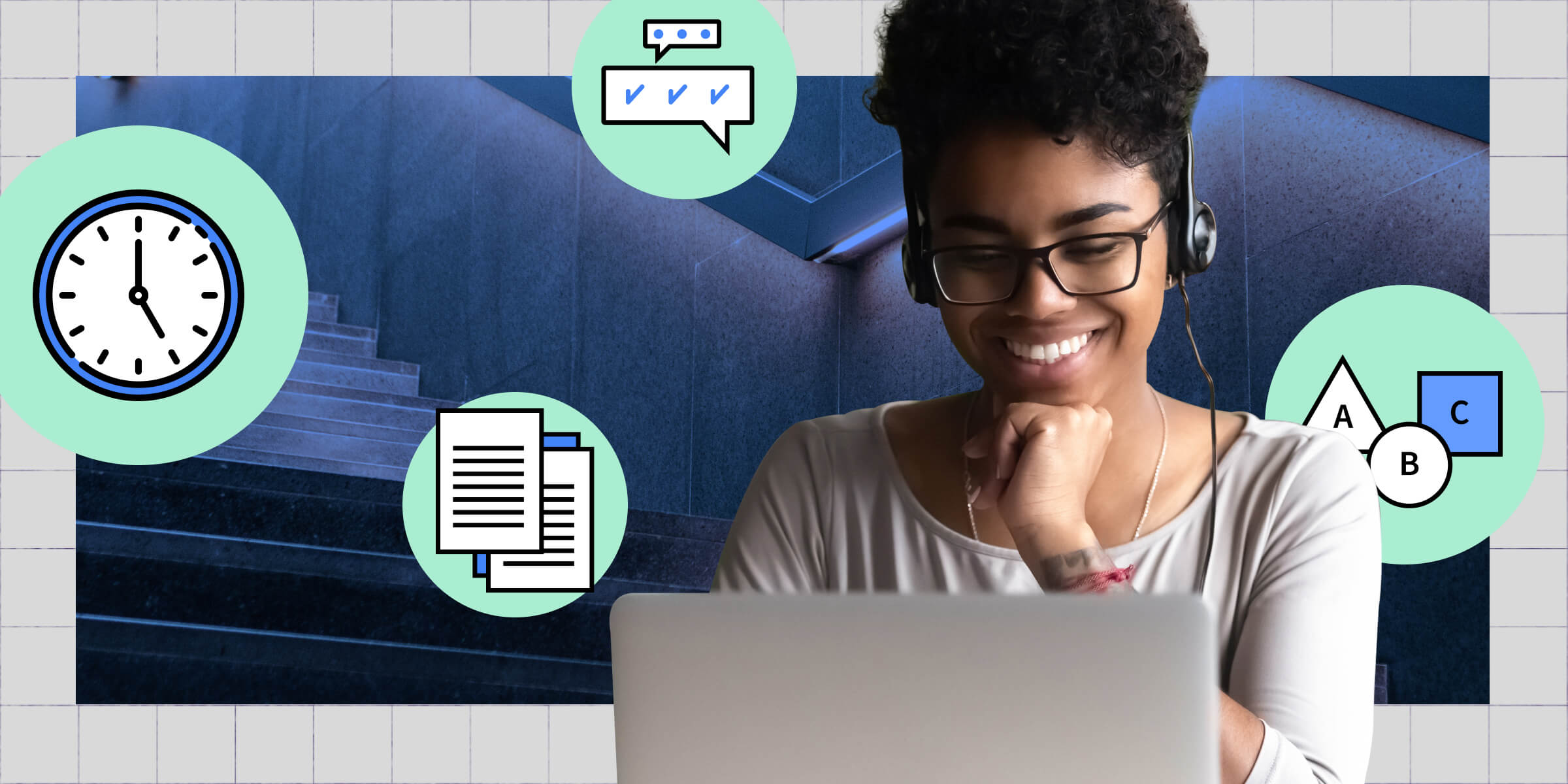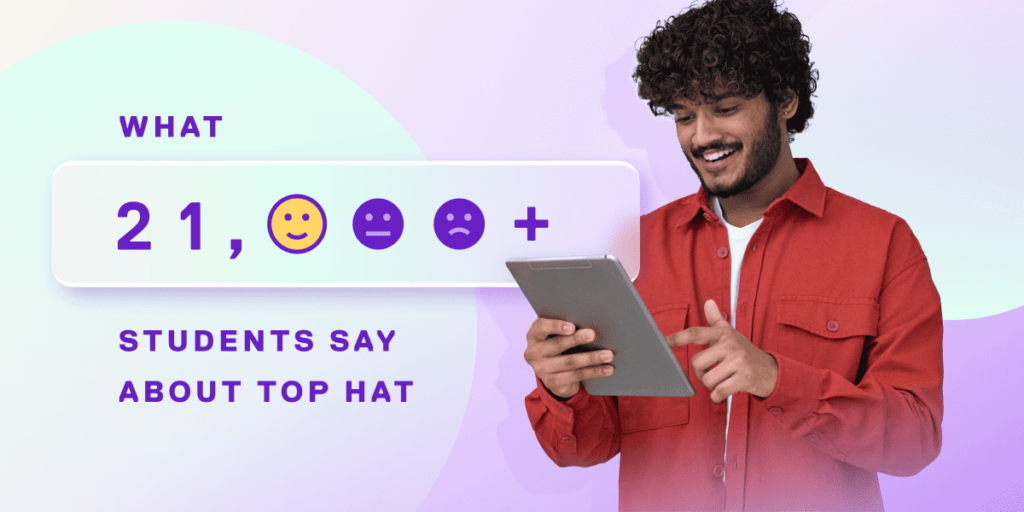No, scaffolding in education has nothing to do with school repairs. Scaffolding is an educational model that’s all about empowering students to set the pace and direction for much of their learning. It offers an effective alternative to standard instruction at all grade levels and classroom sizes, and in any learning environment.
But how do we define scaffolding in education? What does it mean and how does it make for better learning outcomes?
Below, we’ll describe exactly what scaffolding in education is, and provide a few scaffolding strategies for educators interested in implementing it in their college classes.
What is scaffolding in education?
In a 1976 report titled “The Role of Tutoring in Problem Solving,” researchers Jerome Bruner, Gail Ross and David Wood introduced a new educational model they called “scaffolding.” Simply put, it’s based on the idea that students learn new material best when it’s broken down into small, digestible portions. This is distinct from differentiation, which focuses on using different methods for individual students. Educators take the role of “activators,” who break up complex tasks or lessons and present them to students.
As students develop a better handle on the material and assert more control over their own learning, educators gradually remove supports—just as scaffolding is removed from a building under construction. This process is called “fading.” (Educators will still step in as needed, of course.)
One important aim of scaffolding in education is to bridge a student’s current developmental level with their potential one, i.e., what they can do now, versus what they can achieve with the right support. The gap between the two is called the “zone of proximal development.” Instructional scaffolding is aimed at that zone, and at bridging that gap.
How does scaffolding work in synchronous education?
Synchronous education, of course, is the classic classroom experience: teaching students live, all at the same scheduled time, in a physical or virtual classroom. By contrast, asynchronous education is when students access learning material remotely, when and where it suits them. This way, they can meet deadlines but otherwise, learn at their own pace.
Asynchronous learning and scaffolding in education are a seamless fit, both placing emphasis on students taking charge of their own learning process. Teachers can distribute digital material for students to access and apply on their own, and provide means for students to converse and collaborate with one another remotely. Educators can monitor from a distance, stepping in or making themselves available as needed.
What are the benefits of scaffolding in education?
- It’s flexible and scalable: Instructional scaffolding lends itself well to just about any subject, making it useful from K-12 settings all the way up to higher ed. Likewise, it can be scaled up or down, from small groups to large introductory classes.
- It empowers students: By demonstrating key concepts and then stepping back, educators allow students to work with the material in their own way. Students learn the lesson itself, but they also bulk up their cognitive muscles, developing more skills for self-directed learning in the future—in and out of the classroom. At the same time, they develop self-esteem to pursue interests, passions and curiosities.
- It paces learning and enhances comprehension: By breaking complex lessons into smaller chunks, you help students pace themselves realistically. That makes it more likely they’ll fully comprehend and retain the material.
- It improves problem solving: Self-directed learning helps develop and hone powerful problem-solving skills that will be applicable to any real-world topic or idea.
- It elicits greater engagement: It’s hard for students to disengage from the learning process when so much of its success lies in their own hands. Encouraging conversation and interaction with their peers will generate more engagement with the material and the class. Letting students pose and answer their own questions allows them to pursue their own viewpoints and lines of inquiry into a given subject.
- It promotes more positivity in the classroom: Engaged and empowered students are generally happier. And when students are happier, it creates a more effective learning environment for all.
What are the disadvantages of scaffolding in education?
While instructional scaffolding offers many benefits, it’s good to be aware of its limitations and drawbacks as well.
- It requires hands-on monitoring: Scaffolding in education demands enough educators on hand to provide sufficient monitoring of student progress. Moreover, those educators need proper training in scaffolding in order to implement it effectively.
- The fading process can be complicated: During the “fading” period, educators need to develop the ability to relinquish control of the learning process to students.
- Assessments are challenging: The distance that scaffolding in education creates between teacher and student, compared with more hands-on learning methods, can make it tougher to assess students’ actual progress.
- It takes time: Letting students learn new concepts or skills at their own pace can also be more time-consuming.
Scaffolding in education examples: 6 techniques for instructional scaffolding
There are plenty of creative, engaging ways for educators to put instructional scaffolding to use in the classroom. For the greatest chance of success, it helps to match your technique to the topic at hand or your students’ strengths.
Take a look at these six examples for some additional inspiration when putting scaffolding techniques to work, whether in synchronous or asynchronous learning environments.
1. Advance organizers
An advance organizer provides students with a brief introduction to the more complex lessons to come, including their basic principles. This helps students see how each successive lesson builds on previous ones and serves as a preview of where the sequence of lessons is going.
Types of advance organizers include:
- Graphic organizers: These are interactive images that engage students. Digital tools can be very helpful in creating or finding appropriate visuals to use.
- Expository organizers: This simply means that educators verbally explain the link between current and future lessons, and the goal of each lesson.
- Storytelling: Educators using this technique can take discussion topics and frame them as a story—a creative approach to expository organizing.
2. Peer-to-peer discussion
Scaffolding in education isn’t just about students learning on their own—they also learn from one another. Working in pairs or small groups, students can discuss ideas being studied, what they’re struggling with and how to work together to understand lessons.
In asynchronous online settings, this can be achieved by using chat platforms or forums. Educators can even monitor these conversations—a way to practice the “fading” phase of scaffolding without going entirely hands-off. Automated notification systems allow students and educators to know when new comments or questions are posted.
3. Modeling and demonstrating
In the classroom, educators can demonstrate a task, then step aside as students replicate it. In asynchronous settings, it’s not that different: educators can record videos of themselves and post them for students to access at their convenience. Students can then record themselves performing the same tasks for later assessment.
4. Concept maps and mind maps
These are two instructional scaffolding techniques you can use to visually present complex relationships between concepts. Particularly beneficial for more visual learners, these tools can help draw connections among prior, current and future lessons.
5. Tap into previous knowledge and experience
Regardless of technique, it helps to include ways for students to use their own prior knowledge and experience as stepping stones as they learn.
That doesn’t have to be previous classroom learning, either. It can include personal knowledge and experiences unique to each student, which can be connected meaningfully with lessons. In this way, students can better “own” the material, and relate to it in a more lasting way.
6. Traditional instruction
On certain occasions, straightforward, classic instruction may work best in effectively conveying certain material.
Whichever of these or other scaffolding techniques you use, always try to link the new lesson or concepts to a previous one in order to build on a foundation of learning.
Summary
Instructional scaffolding requires teachers to break complex material into fundamental components, present these one at a time to students, and then step back as students work to master each one on their own. It empowers students to learn and grow at their own pace and helps develop lifelong learning skills that will last long after they’ve left the classroom. It works across age groups, classroom sizes and learning settings, including (or even especially) in asynchronous environments.
Most importantly, it’s endlessly flexible, allowing teachers to incorporate the technique into their classrooms in all kinds of creative ways, for any group of students.


